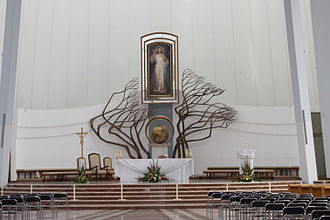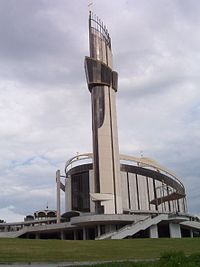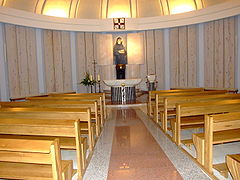- Divine Mercy Sanctuary (Kraków)
-
The Divine Mercy image by Adolf Hyla at the sanctuary.

The Divine Mercy Sanctuary in Kraków, Poland is a Roman Catholic basilica dedicated to the Divine Mercy devotion, as the resting place of Saint Faustina Kowalska.[1][2]
The new basilica was built between 1999–2002, and is located in the District of Łagiewniki at ul. św. Faustyny street. Two Popes have visited the shrine and millions of pilgrims from around the world continue to visit it every year.[3][4]
Contents
History
The site of the building originally housed the neo-Gothic monastery complex of the Sisters of Our Lady of Mercy (founded in 1862), which was designed by Charles Zaremba and was built between 1889–1891. In 1966, the remains of Sister Faustina were moved to the church. In 1968 Cardinal Karol Wojtyla (later Pope John Paul II) designated the church as a shrine, thanks to the remains of Sister Faustina.
In 1985, Pope John Paul II called Lagiewniki the "capital of the Divine Mercy devotion". Since the beatification of Saint Faustina in 1993, her remains rest on the altar, below the image of Divine Mercy.
Interior design and architectural form of the Basilica
In 1999–2002, a modern two-story, ellipsoidal basilica, specifically devoted to the Divine Mercy was built.[3] The building was designed to resemble a boat, and has a 77-meter high observation tower that resembles a mast.
The basilica can accommodate abut 5,000 people and the main chapel has about 1,800 seats.[3] The altar in the main sanctuary houses the Divine Mercy painting and relics of Saint Faustina. The image above the main altar was painted by Adolph Hyla in 1944, and replaces the first image Hyla painted in 1943 as a votive offering for surviving during World War II. The image and the basilica are a major pilgrimage site and in 2011 the basilica received around 2 million pilgrims from around the world.[4]
The lower level of the church has a central a chapel dedicated to Saint Faustina, with four side chapels. The the upper part of the basilica has free-standing post-modern Chapel of Perpetual Adoration of the Blessed Sacrament. On June 24, 2007, on the 60th anniversary of Operation Vistula, the Basilica opened a Greek Catholic chapel dedicated to reconciliation, and as a gift to the Greek Catholic Church.
Report of miracle
In March 1981, while praying to Faustina at the church, Maureen Digan of Massachusetts reported a healing.[5][6] Digan had suffered from Lymphedema for decades, and had undergone 10 operations, including a leg amputation.[7] Digan reported that while praying to Faustina, she heard a voice saying "ask for my help and I will help you" and her constant pain stopped.[7]
Upon her return to the US, five Boston area physicians stated that she was healed (with no explanation). Digan's healing was declared miraculous by the Vatican in 1992, and paved the way for the beatification of Faustina Kowalska.[6][7]
Papal visits
On June 17, 1997 Pope John Paul II visited the church to pray at the tomb of Saint Faustina - an event commemorated by a relief at the entrance to the chapel.
In May 2006, Benedict XVI visited the chapel, and a second relief commemorates that. During the 2006 pilgrimage by Pope Benedict XVI, he unveiled a statue of Pope John Paul II at the observation tower at the basilica, as the seventh sculpture of John Paul II in Kraków.
See also
- Divine Mercy Sanctuary (Plock)
- Divine Mercy Sanctuary (Vilnius)
- National Shrine of The Divine Mercy, Philippines
- National Shrine of The Divine Mercy (Stockbridge, Massachusetts)
References
- ^ Vatican website: Dedication of the Shrine of Divine Mercy Kraków-Łagiewniki August 2002
- ^ Vatican website: Apostolic Journey address by Pope John Paul II at the Shrine, June 7 1997
- ^ a b c Sacred Places Europe by Brad Olsen 2007 ISBN 1888729120 page 138
- ^ a b Lester Meera (2011). Sacred Travels: 274 Places to Find Joy, Seek Solace, and Learn to Live More Fully. Adams Media. p. 53. ISBN 1440524890. http://books.google.ca/books?id=glrLioBQ3QkC&pg=PA53&dq=%2251.+Basilica+of+Divine+Mercy%22&hl=en&ei=GQ4XTq7iIZLSiAKPpqHSBQ&sa=X&oi=book_result&ct=result&resnum=1&ved=0CDAQ6AEwAA#v=onepage&q=%2251.%20Basilica%20of%20Divine%20Mercy%22&f=false. Retrieved July 9, 2011.
- ^ Judy Roberts, Legatus magazine, May 1, 2010
- ^ a b Tim Drake, 2002, Saints of the Jubilee, Authorhouse ISBN 9781403310095 pages 85-95
- ^ a b c Catherine M. Odell, 1998, Faustina: Apostle of Divine Mercy OSV Press ISBN 9780879739232 pages 159-160
Categories:- Catholic pilgrimage sites
- Roman Catholic devotions
Wikimedia Foundation. 2010.



